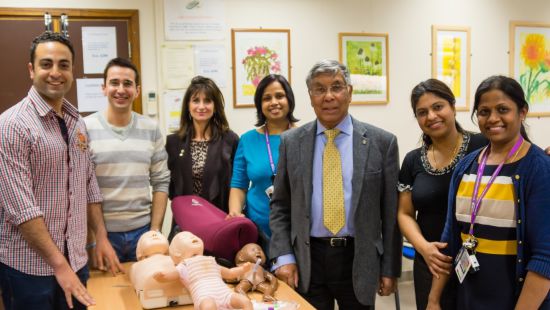Maternal Mortality Reduction - Vocational Traning Team
 Executive Director Melissa Willis speaking with Medical Director Dr. Himansu Basu about Vocational Training Teams (VTT). Please read on……… Executive Director Melissa Willis speaking with Medical Director Dr. Himansu Basu about Vocational Training Teams (VTT). Please read on………
Missy – Himansu, Good morning. What is a Vocational Training Team (VTT) please?
Himansu - A vocational training team (VTT) is a group of professionals (at least two) with at least two years relevant professional experience, who travel to another country either to learn more about their profession or to teach local professionals about a particular field. Under Future Vision, Rotary Foundation district, global, and packaged grants all support VTTs, but each grant type has different requirements. Vocational Training Team (VTT) represents new opportunities for Rotary Service, especially through the Training the Trainer (TTT) model.
M - What is your interest in VTT?
H – A lot really. As an RFPD Board Member, a Rotarian, and a Professional (Ob- Gyn Specialist) of some years standing, I wish to contribute everything I have to Rotary Humanitarian Service. This includes financial support, hands on vocational efforts and advocacy roles. Vocational Training Team (VTT) gives me an opportunity to incorporate all three resources in promoting effective sustainable humanitarian programmes fit for the 21st century.
M- Why is this important?
H- This allows us, ordinary Rotarians, to do extraordinary things. In particular it allows us to tackle larger programs in one of the areas of focus, for example, maternal and child health, without spending a lot of time in fund raising.
M- Can you please tell us how you start a VTT programme?
H- I have been involved with an innovative Rotary Foundation VTT Global Grant programme for improvement of maternal health, reduction of maternal and new born mortality called CALMED (Collaborative Action in Lowering of Maternity Encountered Deaths). It consists of training local master trainers in emergency care of pregnant women and new born babies – they in turn train many local professionals involved in maternity care through a process of fast track knowledge and skills transfer. This leads to capacity development and sustainability in creating a large cohort of trained professionals in the care of the pregnant women and the new born.
The second component of the program rests on community mobilisation through village women’s groups who are given awareness on matters of health, family spacing, features of abnormal labour etc., by Government health activists (ASHAs).
The third component relies on advocacy role of Rotarians in partnership with the Government in securing and sustaining resources related to improvement of maternal and child health .Monitoring and Evaluation is also part of this advocacy.
M- How did your VT program start?
H- The programme originated at a meeting in Delhi, India in September 2010 ,of all stakeholders working on MDG 5 - reduction of Maternal Mortality Ratio by three quarters (109) by 2015 ( baseline was the Ratio in 1990). Collaborators including FIGO, GLOWM and NRHM joined Rotary to propose the CALMED solution, incorporating a strong VTT component. Other collaborators joining subsequently include LAERDAL, MAF and AYZH. Our collaborators add resources and support for our VTT programme.
M- Can you give examples of resources accessed for your VTT program?
H- Funding is by a Rotary Foundation Global Grant financed by DDF from two Rotary Districts (1120 and 3240). Collaborators added professional support ( FIGO) ,Implementation pathway ( NRHM) ,Simulators (LAERDAL),Training Materials( GLOWM) ,Films ( MAF) and Birthing Kits ( AYZH).
M- You are about to send a second VTT - how do you organise a VTT?
H- We were in contact with a District with need (High Maternal Mortality Ratio, MMR), then undertake a preliminary reconnaissance visit to secure agreement from the Government (NRHM) about implementing our programme in areas selected by the Government .Government (National Rural Health Mission, NRHM) then identified the local trainers and trainees, resources for training and ASHAs (Accredited Social Health Activists) for raising awareness.
Professional members of VTT (6 in all) and a Rotarian Team Leader were selected, briefed and equipped before the visit. VTT visit to Sikkim (RI District 3240) lasted two weeks. A humanitarian programme (training and donation of fetal heart monitoring equipment) was added. We will undertake two return visits within the life of the project which is 3 years.
M- What measurable outcome have you recorded?
H- Tests before and after our training in Sikkim showed highly significant improvement of knowledge and skills. After 12 months, maternal mortality Ratio dropped from 350 to 150. So far 13 Master Trainers and 124 professionals have been trained. We have established women’s groups in 8 Villages. These numbers are on the increase.
M- Himansu you spoke of numbers, are there any quality issues you wish to highlight in this program?
H – We used a revolutionary method of training using fewer lectures, but more Simulators, Role plays, DVDs and Charts. The programme has other benefits on Population issues, Gender inequality issues, and women’s health concerns. Individual components of the programme has clearly defined benefits based on evidence.
M- Have you any plans to extend the program?
H- We are taking a VTT to Bhuj, Gujarat, India, R.I. District 3051, in November 2014. . We are preparing for our next VTT Global Grant in Indore, Madhya Pradesh, District 3040, in 2015.
M- That is encouraging news. We wish you success.
H- Thank you Missy for raising awareness of our VTT program. |